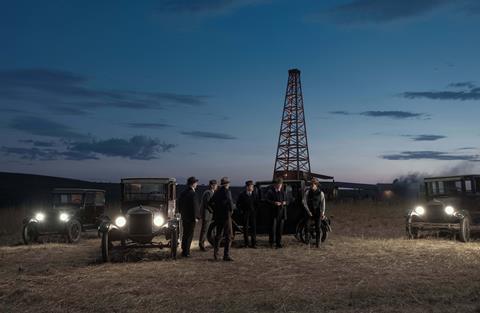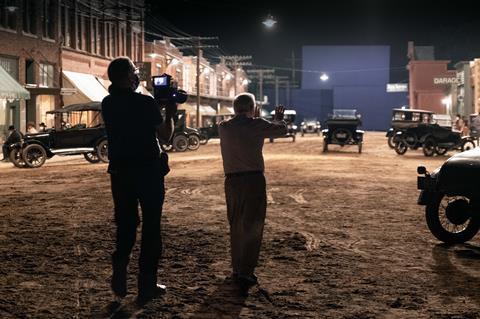Martin Scorsese’s official selection title Killers Of The Flower Moon was shot mainly on location in Oklahoma. Screen talks to producer Daniel Lupi about filming on the Osage County reservation

Martin Scorsese’s Killers Of The Flower Moon went through some significant changes over the years before it reached the screen. But one of the constants — besides the involvement of the director and his frequent collaborators Leonardo DiCaprio and Robert De Niro — was Scorsese’s intention to shoot in Oklahoma, the southern US state where the historical events depicted in the film took place a hundred years ago.
“There was no other place he would have made the movie,” says Daniel Lupi, one of the film’s producers as well as its unit production manager, who joined the project in mid-2020.
Based on the 2017 non-fiction book by David Grann and written for the screen by Scorsese and Eric Roth, the three-and-a-half-hour historical crime drama — which is making its world premiere out of Competition in Cannes’ official selection — is set in 1920s Oklahoma and centres on the murders of members of the Osage Nation, the midwestern Native American tribe that became wealthy after the discovery of oil on their land at the end of the 19th century. The series of brutal crimes, revealed by the then-fledgling FBI to have been a conspiracy by several local white residents, became known as the Reign of Terror.
Originally set up at Paramount in the summer of 2019, the project was delayed by the pandemic and the search for an additional backer to help cover the reported $200m budget. Apple Studios stepped up to co-finance and co-distribute with Paramount, and to produce alongside Imperative Entertainment, Scorsese’s Sikelia Productions and DiCaprio’s Appian Way.
Also helping to cover the budget — which Lupi insists was smaller than the reported figure — was a rebate from Oklahoma’s generous production incentive programme. However, it was Scorsese’s focus on historical accuracy and his commitment to working with the Osage Nation — which today has a population of close to 24,000 — that made Oklahoma, and the tribe’s Osage County reservation in particular, the essential location.
From early on, Scorsese had been closely involved in working with the Osage Nation. “We were very ingrained with the Osage community and the tribal leaders and chief,” says Lupi. “The Osage were incredibly engaged to make sure we were telling a historical story in the proper way, which I believe we have done.”
Home team

After another Covid-enforced delay at the start of 2021, Killers Of The Flower Moon began its nearly 100‑day shoot in April that year, with a crew of 400 people drawn from all over the US.
While most of the heads of department came from outside Oklahoma, Osage Nation members and other Oklahomans were recruited for the costume, construction and production and accounting departments, and to advise on the use of the Osage language spoken in the film. Around half of the extras hired for the 8,000 person-days of background work were from the Osage or other Native American Indigenous groups.
The production was based in Bartlesville, a small city on the edge of Osage County, and a few sets were built in a hangar rented from the city’s municipal airport. Houses for two key characters in the story, and a part of the town of Gray Horse, where some of the murders took place, were reconstructed on Osage County’s famous, privately owned Drummond Ranch.
There was also a brief shoot at the classical revival-style period courthouse in Tulsa, Oklahoma’s second largest city.
Most of the filming, though, was done around two of the towns where the Reign of Terror held sway: Fairfax, where most of the murders occurred, and Pawhuska, then an oil boom centre with a population of 6,000, now a town half the size and the base of the Osage Nation’s tribal government. Lupi attributes the preference for real locations to the film’s production designer Jack Fisk (Days Of Heaven), who had worked in the area on Terrence Malick’s 2012 film To The Wonder.
“Jack was very much about historical accuracy,” says Lupi. “He was drawn to buildings that were actually where things happened.”
Shooting in historic downtown Pawhuska — now the retail headquarters of cooking and lifestyle guru Ree Drummond, known for her The Pioneer Woman brand and TV show — posed some problems, however. “When we arrived in 2020, it was a town in renewal,” explains Lupi. “You could see it changing before your eyes. There were a lot of new businesses going into empty store fronts.”
Fortunately for the production, “the properties we shot in had not been developed, they still had the bones from the 1920s”.
There were plenty of other challenges, too. To depict the period’s mix of Old West and more modern cultures, the production needed horses and a wrangler but also a fleet of 100 vintage vehicles, with four mechanics to maintain them. A period steam train was brought into the state and track laid leading to a station set that was used for a week.
Scorsese’s choice to shoot on film meant that footage had to be sent to a lab in Los Angeles every night. And every day the production had to deal with the heat and humidity of a southern summer, not to mention occasional lightning and the threat of tornadoes, Oklahoma being part of North America’s so-called Tornado Alley. “We would track lightning and stop shooting if it was too close,” Lupi says. “We had a couple of tornado warnings, but nothing close.”
Testing shoot
The biggest challenge, though, was Covid. With the shoot taking place in the lull between a winter spike and the arrival in the US of the delta variant in summer 2021, the set demanded maximum Covid protocols, including the employment of a special team to move air conditioning equipment from location to location, ensuring proper circulation in enclosed areas.
Labs in Pawhuska and Bartlesville were set up to process most of the 75,000 tests conducted during the shoot. There were, not surprisingly, some positive cases, but the production was never forced to shut down by a serious outbreak.
Once the worst of the pandemic passed, shooting was completed with brief stints in February and June 2022 — the first to film at Scorsese’s old high school in New York for a modern day wrap-up, and the second to capture footage of a ceremonial Osage dance in Oklahoma that would have been too risky to shoot when Covid was still a major threat.
Once Killers Of The Flower Moon is unveiled in Cannes, the film is being released theatrically worldwide though Paramount in October, with a streaming launch on Apple TV+ to follow. The global rollout, under an Apple Original Films banner, will make the film a big event for the state of Oklahoma and North America’s rapidly developing Indigenous film and TV industry. But it will also be a likely awards contender and a flagship for a reported new theatrical strategy at Apple, where films have, up to now, been given streaming debuts or only limited theatrical releases.
Meanwhile, UK-born Lupi, who moved to the US as a teenager, says he returned from Oklahoma with an appreciation for its Great Plains landscape and its people. “I spent probably a year there and a lot of the crew spent similar lengths of time. The people were incredibly friendly. I think I spoke to the guy I bought coffee from more than I have ever spoken to anyone in any of the other cities I have lived in.”
Lupi has worked as a producer, executive producer and unit production manager on films such as There Will Be Blood, Lincoln and Phantom Thread, with directors Paul Thomas Anderson and Steven Spielberg. But Killers Of The Flower Moon “was the hardest movie I have ever worked on”, he reveals. “It was a massive undertaking in Oklahoma, and Covid just brought that much more of a challenge. It was an incredibly rewarding project also.”






![The Brightest SunScreen[Courtesy HKIFF]](https://d1nslcd7m2225b.cloudfront.net/Pictures/274x183/3/5/0/1448350_thebrightestsunscreencourtesyhkiff_312678.jpg)


















No comments yet